Don’t have time for full reviews of comics? Then check out Graphic Bits: bite sized chunks of comic book goodness designed to get behind the panels and into your hearts.
This week (1 May 2013) is another big one! First up, we check in with the Andy Diggle/Tony S. Daniel Action Comics #20 (DC Comics), before watching Age of Ultron #7 (Marvel) go completely off the rails. Then it’s archer vs. archer as we review both Green Arrow #20 (DC Comics) and Hawkeye #10 (Marvel). Then, from the days of pulp fiction it’s the return of Black Bat #1 (Dynamite). Finally, has Thanos Rising #2 (Marvel) gotten any better? This is Graphic Bits.
Other reviews…Don’t forget, each week we also feature a single outstanding or high-profile issues. This week is so big, we’ve featured a couple. Check out full reviews for The Movement #1, the digital-only Adventures of Superman #1 and Ten Grand #1.
Action Comics #20 – DC Comics, Andy Diggle, Tony S. Daniel (writers), Tony S. Daniel (artist)
Back-up story: Scott Lobdell, Frank Hannah (writers), Philip Tan (artist)
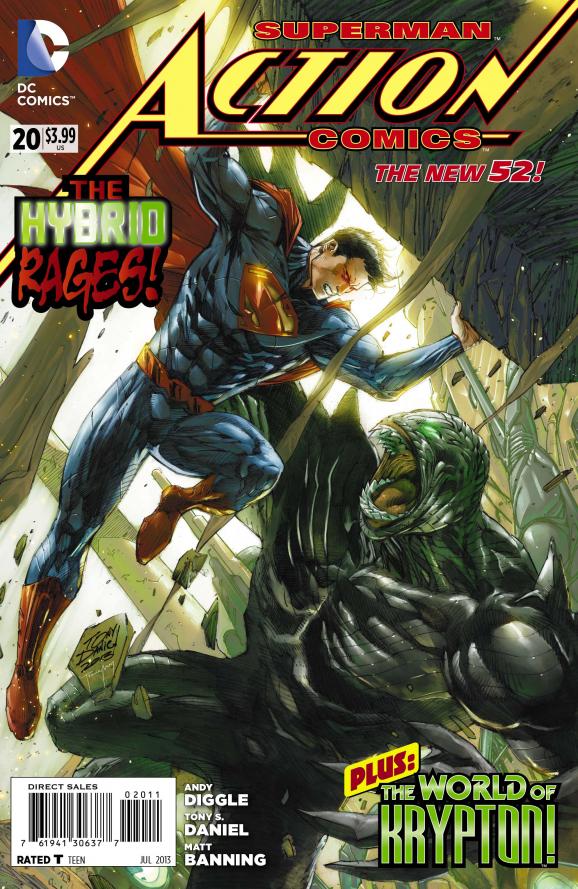 The digital-first Adventures of Superman #1 took the Newish 52 to school this week on how to deliver an old-school Superman story that was still relevant to modern readers. Last month, Diggle began the story arc “Hybrid”, and we praised it for being a return to that very kind of story. It continues this month with a co-credit for Daniel, who has allegedly taken over scripting duties from Diggle’s plotting following his well-publicised departure from the book. It hasn’t impacted on the quality of the title, which is still an exceedingly solid piece of Superman fiction. This story, set “one year ago”, is much closer to the Superman of the other titles, and the intriguing development of a virus that mutates using Superman’s DNA is setting up all sorts of possibilities. However, the introduction of a zombie style subplot is a bit of pandering to the trends. Lex Luthor is also classic stuff, almost the same one we saw in the final pages of Adventures of Superman. Daniel’s art is still the same blend of modern and retro, and it is a pleasing mix. A real treat this month is a back-up story by Scott Lobdell and Philip Tan called “The World of Krypton”. It deals with a younger Jor-El, and an assassination attempt on the science council during Krypton’s pre-kaboom days. This intriguing plot will presumably play out over the next few issues, as we continue to plumb Superman’s heritage in this new DC continuity.
The digital-first Adventures of Superman #1 took the Newish 52 to school this week on how to deliver an old-school Superman story that was still relevant to modern readers. Last month, Diggle began the story arc “Hybrid”, and we praised it for being a return to that very kind of story. It continues this month with a co-credit for Daniel, who has allegedly taken over scripting duties from Diggle’s plotting following his well-publicised departure from the book. It hasn’t impacted on the quality of the title, which is still an exceedingly solid piece of Superman fiction. This story, set “one year ago”, is much closer to the Superman of the other titles, and the intriguing development of a virus that mutates using Superman’s DNA is setting up all sorts of possibilities. However, the introduction of a zombie style subplot is a bit of pandering to the trends. Lex Luthor is also classic stuff, almost the same one we saw in the final pages of Adventures of Superman. Daniel’s art is still the same blend of modern and retro, and it is a pleasing mix. A real treat this month is a back-up story by Scott Lobdell and Philip Tan called “The World of Krypton”. It deals with a younger Jor-El, and an assassination attempt on the science council during Krypton’s pre-kaboom days. This intriguing plot will presumably play out over the next few issues, as we continue to plumb Superman’s heritage in this new DC continuity.
Rating: ★★★½
The Black Bat #1 – Dynamite, Brian Buccellato (writer), Ronan Cliquet (artist)
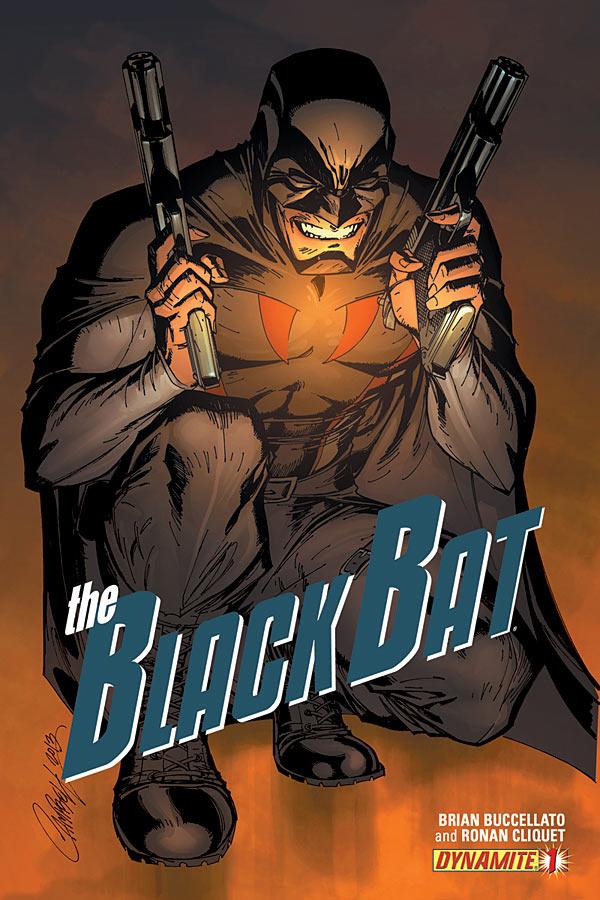 “I’ll be damned if I’m gonna let the inmates run the asylum…”. With that, The Black Bat is reintroduced to the 21st century as part of Dynamite’s pulp revival. Originally created in the 1930s, around the same time as Batman, it would be easy to see this blinded district attorney with enhanced vision as derivative of Daredevil. Yet his origin is almost three decades earlier, and he is much closer in tone to DC’s famous Bat. That’s the trouble with bringing back pulp heroes, as many of them came from a similar place, and the ones that have survived have over seven decades of continuous stories behind them. Writer Brian Buccellato doesn’t vary the old-school formula much, and this is perhaps one of the strengths (and weaknesses) of the material. Knowing readers will come to this with a sense of history, but newer ones may not get that the character pre-dates the works it influences. Either way, the straightforward narrative is a good little mystery yarn, and remains engaging throughout. Ronan Cliquet’s art elevates this pulp fiction somewhat as well, bringing the vivid hyper-realism of dime store novel covers to every single page. Restricting colour use (by Mat Lopes) mostly to blacks, browns, greys and blues keeps with the current genre trends, but still makes for an effective set of excellently rendered action scenes and gritty city settings. We’ll be keeping an eye on this one, as it might just be set to be a sleeper cult hit.
“I’ll be damned if I’m gonna let the inmates run the asylum…”. With that, The Black Bat is reintroduced to the 21st century as part of Dynamite’s pulp revival. Originally created in the 1930s, around the same time as Batman, it would be easy to see this blinded district attorney with enhanced vision as derivative of Daredevil. Yet his origin is almost three decades earlier, and he is much closer in tone to DC’s famous Bat. That’s the trouble with bringing back pulp heroes, as many of them came from a similar place, and the ones that have survived have over seven decades of continuous stories behind them. Writer Brian Buccellato doesn’t vary the old-school formula much, and this is perhaps one of the strengths (and weaknesses) of the material. Knowing readers will come to this with a sense of history, but newer ones may not get that the character pre-dates the works it influences. Either way, the straightforward narrative is a good little mystery yarn, and remains engaging throughout. Ronan Cliquet’s art elevates this pulp fiction somewhat as well, bringing the vivid hyper-realism of dime store novel covers to every single page. Restricting colour use (by Mat Lopes) mostly to blacks, browns, greys and blues keeps with the current genre trends, but still makes for an effective set of excellently rendered action scenes and gritty city settings. We’ll be keeping an eye on this one, as it might just be set to be a sleeper cult hit.
Rating: ★★★½
Age of Ultron #7 – Marvel, Brian Michael Bendis (writer), Brandon Peterson and Carlos Pacheco (artists)
 We are now on the home stretch for this big event series, and Brian Michael Bendis has once again been all foxy and pulled the rug out from under us. Following the “shocking” ending of the previous issue, in which an Avenger was killed in the past by Wolverine and Sue Storm to stop the events of Age of Ultron, the duo return to the “present” (let’s call is 2013A) to find things drastically changed. They are confronted with an alternate team of superheroes, ones for whom the Kree-Skrull war turned out very differently. On the surface, this is a fun piece of time travel/parallel universe capering, although somewhat reminiscent of Bendis’s House of M and the Age of Apocalypse/X-Treme X-Men/X-Termination story arcs that have done it all before. More troubling is that this is no longer the Age of Ultron, the world Bendis spent half-a-dozen issues slowly building up with talk-fests that we still hold out hope will lead somewhere. Without warning we are in a third dimension, one that seemingly bears little relevance to what has come before. With three issues (and some crossovers) left to go, the direction is now unclear, although not in a way that makes us necessarily excited about the next installment. Brandon Peterson and Carlos Pacheco have a cleaner and more consistent style that the last issue, getting to cut loose on the alternate Defenders, dinosaurs and lots of robots all in a single issue. An artist’s dream perhaps, it’s just a shame that the story might send seasoned readers off to the land of nod.
We are now on the home stretch for this big event series, and Brian Michael Bendis has once again been all foxy and pulled the rug out from under us. Following the “shocking” ending of the previous issue, in which an Avenger was killed in the past by Wolverine and Sue Storm to stop the events of Age of Ultron, the duo return to the “present” (let’s call is 2013A) to find things drastically changed. They are confronted with an alternate team of superheroes, ones for whom the Kree-Skrull war turned out very differently. On the surface, this is a fun piece of time travel/parallel universe capering, although somewhat reminiscent of Bendis’s House of M and the Age of Apocalypse/X-Treme X-Men/X-Termination story arcs that have done it all before. More troubling is that this is no longer the Age of Ultron, the world Bendis spent half-a-dozen issues slowly building up with talk-fests that we still hold out hope will lead somewhere. Without warning we are in a third dimension, one that seemingly bears little relevance to what has come before. With three issues (and some crossovers) left to go, the direction is now unclear, although not in a way that makes us necessarily excited about the next installment. Brandon Peterson and Carlos Pacheco have a cleaner and more consistent style that the last issue, getting to cut loose on the alternate Defenders, dinosaurs and lots of robots all in a single issue. An artist’s dream perhaps, it’s just a shame that the story might send seasoned readers off to the land of nod.
Rating: ★★½
Green Arrow #20 – DC Comics, Jeff Lemire (writer), Andrea Sorrentino (artist)
 The amount of praise we are heaping on this new run is starting to get embarrassing, but if ever there was an example of a comeback kid, then it’s Green Arrow. Lemire reaches a conclusion of sorts to his first arc on the series, firmly making Komodo a certified part of a modern rogue’s gallery. Cut between the desert story and the city fight, both arcs make significant progress in this issue, and we are a few steps closer to unravelling at least one of the mysteries Lemire has presented us so far, but leaves us with a whole lot more. For the first time since the start of the Newish 52, Green Arrow is consistently leaving us gagging for the next issue, which should be the primary job of all ongoing series. Of course, it’s Sorrentino (alongside master colourist Marcelo Maiolo) who deserve at least half of the credit for this book’s current magnificence. Every panel is fit to frame, with the absence of colour being just as important to a particular scene as vividly highlighting it in another. It’s actually somewhat ironic that Lemire’s plotting is more traditional, drawing on clear influences from past Arrow eras, but it is this traditionalism that makes it stand out in stark contrast to the consciously “different” approaches in the rest of the DCU. Another must -read this month.
The amount of praise we are heaping on this new run is starting to get embarrassing, but if ever there was an example of a comeback kid, then it’s Green Arrow. Lemire reaches a conclusion of sorts to his first arc on the series, firmly making Komodo a certified part of a modern rogue’s gallery. Cut between the desert story and the city fight, both arcs make significant progress in this issue, and we are a few steps closer to unravelling at least one of the mysteries Lemire has presented us so far, but leaves us with a whole lot more. For the first time since the start of the Newish 52, Green Arrow is consistently leaving us gagging for the next issue, which should be the primary job of all ongoing series. Of course, it’s Sorrentino (alongside master colourist Marcelo Maiolo) who deserve at least half of the credit for this book’s current magnificence. Every panel is fit to frame, with the absence of colour being just as important to a particular scene as vividly highlighting it in another. It’s actually somewhat ironic that Lemire’s plotting is more traditional, drawing on clear influences from past Arrow eras, but it is this traditionalism that makes it stand out in stark contrast to the consciously “different” approaches in the rest of the DCU. Another must -read this month.
Rating: ★★★★½
Hawkeye #10 – Marvel, Matt Fraction (writer), Francesco Francavilla (artist)
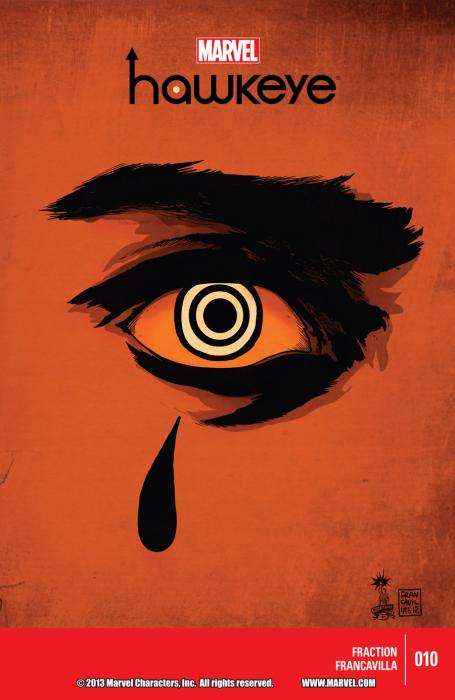 Speaking of reliable workhorses, Fraction’s Hawkeye has been so effortlessly brilliant since it began that we wonder if these books are simply willed into existence and not written by mortal man. Following the tragic events at the end of the previous issue, Fraction actually takes us back to just before that time to run a parallel story. Here Kate mostly takes centre stage, and her encounter with the mysterious Kazi, an Eastern European hitman who introduces himself as coming “from Hell”. As the issue concludes, the identity of the murderer in the previous issue is revealed. Once again, Fraction manages to give us what looks like a stylised surface sheen that is cool for cool’s sake, only to spin it about and reveal that the plot device was essential information after all. We really should just learn to trust it by now. Regular readers may be clutching their chests in horror at the absence of David Aja from this issue, who has undoubtedly given the book its characteristic flavour up until this point. Of course, Francesco Francavilla is no mere “fill in” artist, and his layouts and colours are nothing short of magnificent. Panels range from being meticulously arranged, to ripped pages, shattered glass or even postcards tossed over a New York map. Use of colour gives it a taste of noir or steamy pulp, lit and shaded in the same bold fashion as Piotr Kowalski’s Sex or Sean Phillips’s Fatale. In conversation, Kate is lit in purple, and Kazi a kind of blue. Flashbacks are given an orange flavour, and that occasionally creeps into the main story as well. If this was a standalone issue, it would be a near-perfect piece of sequential art and plotting. The fact that it seems to be the beginning of a downward spiral for Clint Barton makes it all the richer. This is essential reading.
Speaking of reliable workhorses, Fraction’s Hawkeye has been so effortlessly brilliant since it began that we wonder if these books are simply willed into existence and not written by mortal man. Following the tragic events at the end of the previous issue, Fraction actually takes us back to just before that time to run a parallel story. Here Kate mostly takes centre stage, and her encounter with the mysterious Kazi, an Eastern European hitman who introduces himself as coming “from Hell”. As the issue concludes, the identity of the murderer in the previous issue is revealed. Once again, Fraction manages to give us what looks like a stylised surface sheen that is cool for cool’s sake, only to spin it about and reveal that the plot device was essential information after all. We really should just learn to trust it by now. Regular readers may be clutching their chests in horror at the absence of David Aja from this issue, who has undoubtedly given the book its characteristic flavour up until this point. Of course, Francesco Francavilla is no mere “fill in” artist, and his layouts and colours are nothing short of magnificent. Panels range from being meticulously arranged, to ripped pages, shattered glass or even postcards tossed over a New York map. Use of colour gives it a taste of noir or steamy pulp, lit and shaded in the same bold fashion as Piotr Kowalski’s Sex or Sean Phillips’s Fatale. In conversation, Kate is lit in purple, and Kazi a kind of blue. Flashbacks are given an orange flavour, and that occasionally creeps into the main story as well. If this was a standalone issue, it would be a near-perfect piece of sequential art and plotting. The fact that it seems to be the beginning of a downward spiral for Clint Barton makes it all the richer. This is essential reading.
Rating: ★★★★★
Thanos Rising #2 – Marvel, Jason Aaron (writer), Simone Bianchi (artist)
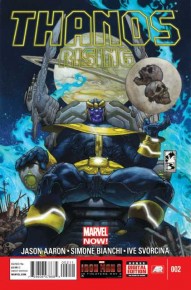 Last month, one of Marvel’s foundation titles for the year of all things cosmic not only failed to excite, but it completely diminished any power its titular Titan might have. This second issue sees a character no longer afraid of death and killing, but completely fascinated by it. He experiments by cutting open all sorts of animals to learn the secrets of life and death, but at the encouragement of a pale young girl, he soon graduates to people. This issue holds together a little better than the first, no longer treading dangerously close to Saturday morning cartoon territory. Genuine character traits are revealed in Thanos, and his transition from disenfranchised teen to galactic genocidal giant is a little easier to connect to. However, it has instead borrowed heavily from another genre, with this essentially being the story of the rise of a serial killer, not someone who will one day bring the galaxy to its knees in his mad pursuit for power. In other words, we’ve seen it all before. Aaron virtually hits us over the head with his themes, especially the ubiquitous raven-haired girl. If she isn’t Death herself, then it has been telegraphed so heavily that any other reveal will be expected to be shocking. More than a saving grace is Bianchi’s art, and while the skinny and awkward teenage Thanos is still not something that sits right with us, the rest of the book looks gorgeous. As this promises to tie-in with the unfolding cosmic ballet in Guardians of the Galaxy and Nova, we’re locked in now. Yet the next chapter will have to really deliver for us to invest any more emotion in these characters.
Last month, one of Marvel’s foundation titles for the year of all things cosmic not only failed to excite, but it completely diminished any power its titular Titan might have. This second issue sees a character no longer afraid of death and killing, but completely fascinated by it. He experiments by cutting open all sorts of animals to learn the secrets of life and death, but at the encouragement of a pale young girl, he soon graduates to people. This issue holds together a little better than the first, no longer treading dangerously close to Saturday morning cartoon territory. Genuine character traits are revealed in Thanos, and his transition from disenfranchised teen to galactic genocidal giant is a little easier to connect to. However, it has instead borrowed heavily from another genre, with this essentially being the story of the rise of a serial killer, not someone who will one day bring the galaxy to its knees in his mad pursuit for power. In other words, we’ve seen it all before. Aaron virtually hits us over the head with his themes, especially the ubiquitous raven-haired girl. If she isn’t Death herself, then it has been telegraphed so heavily that any other reveal will be expected to be shocking. More than a saving grace is Bianchi’s art, and while the skinny and awkward teenage Thanos is still not something that sits right with us, the rest of the book looks gorgeous. As this promises to tie-in with the unfolding cosmic ballet in Guardians of the Galaxy and Nova, we’re locked in now. Yet the next chapter will have to really deliver for us to invest any more emotion in these characters.
Rating: ★★½
Agree or disagree? Got a comment? Start a conversation below, or take it with you on Behind the Panel’s Facebook and Twitter!
If you are an iTunes user, subscribe to our weekly podcast free here and please leave us feedback.

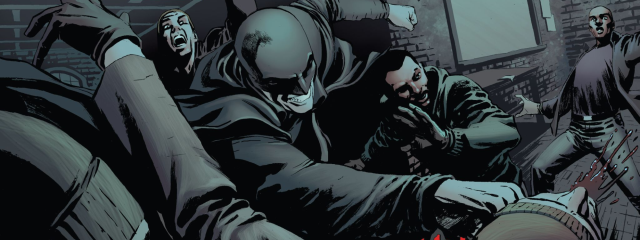

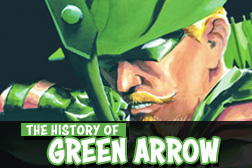

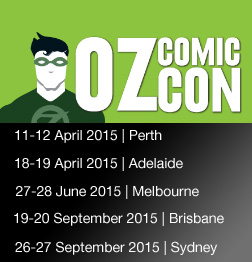





2 pings
[…] brought about by AU Wolverine and Susan Reed killing Hank Pym in the past, where we also spent last issue, Bendis has begun to repeat many of the earlier sins in the series. He has merely transplanted them […]
[…] the addition of Black Beetle artist Francesco Francavilla (who had previously served art duties on Hawkeye #10) is a natural fit. In this issue Fraction introduces a dishevelled Barney Barton (formerly […]